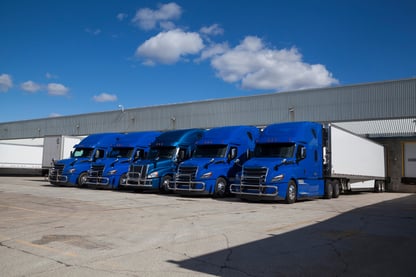Docks are often the busiest and most dangerous areas in warehouses or distribution companies. If it does not follow the proper safety procedures, serious accidents can occur.
Per OSHA, every year more than 20 workers are killed in accidents involving semi-trucks at loading docks. In addition, forklift-related fatalities occur every 3 days, and non-fatal forklift accidents are much more common, with about 94,750 reported cases each year.
Some of the most common employee injuries include:
- Slips, trips, and falls
- Being struck by a forklift or other vehicle
- Heavy objects or cargos falling
- Human error
When something occurs, it can cause major problems for the company and can lead to loss of productivity, injury, or worse.
Here are tips that can help improve employee safety and productivity at loading docks.
Loading Dock Safety: At the Dock Door
Loading docks are often exposed to the elements, making them dangerous in wet or icy conditions. Wet and icy floors are a recipe for slips, trips, and falls, which could lead to both injuries and accidents.
 So, assess the dock door area.
So, assess the dock door area.
- Is there a sufficient drainage system in place?
- Are there any cracks, holes, or gaps on the floor surfaces?
- Do you have a good seal around the perimeter of the door opening?
- Do you have adequate dock handrails and visible barriers?
- What is the surface of the loading area? Is it compatible with the truck wheels and your loading equipment?
- Are trucks secured with wheel chocks?
- Are employees wearing protective equipment, like bright vests and hats?
What about inside the dock?
Loading Dock Safety: Inside the Docks
There are many things that can go wrong when working inside the loading dock. To ensure your workers’ safety, here are some tips:
First, look at the height of the ceiling and any overhead equipment. Make sure that the forklift you’re using has enough clearance to drive safely and maneuver in the area. Pay attention to aisle width. It needs to be wide enough so that two forklifts can pass each other safely. Also, make sure that there are no protruding hooks, beams or posts that could cause injuries.
Second, the receiving area should be free from obstructions, such as pallets, boxes, crates, barrels, carts, etc. These items can trip, fall on top of someone, or even roll away if left unattended. Make sure that you have a clear path for the trucks to enter and exit the dock. Are there any slippery or soft areas inside that could cause an accident? If so, put some caution signs up to warn employees and truck drivers.
Third, use only approved lifting devices like hoists, forklift, boom lifts, power ramps and pallet jacks. Make sure they’re in good working condition. And that it is safe for your trained employees to operate the equipment when moving cargos and other forms of material.
Fourth, the dock should have adequate lighting. Not only does good lighting allow for better visibility, but it also helps prevent accidents caused by poor lighting.
Fifth, employees should clearly understand the potential for serious injury if they walk or stand under a load that is suspended by a crane or other lifting device.
Finally, safety signs should be posted to inform employees and visitors of potential hazards in the area. For example, signs may state “No Loading” or “No Unloading.” These signs will help prevent accidents and confusion among dockworkers and delivery truck drivers.
Loading Dock Safety: Crime Prevention
Loading dock crimes are unfortunately all too common, and can include theft, vandalism, assault, robbery, burglary, arson, and murder. This is one area where extensive security measures should be taken to protect both employees and merchandise.
Worldwide, the direct cost of cargo theft exceeds $30 billion annually and $10 billion in the United States alone, with indirect costs many times higher. On top of the cargo costs, losses are amplified by double or more due to investigative and insurance costs. -Cisco- Eagle2
The first line of defense against theft is proper security measures.
 Ensure that all exterior doors have locks and/or chains, and make sure they are locked when not in use. Also, ensure that the area is well lit, as thieves like to operate in the shadows.
Ensure that all exterior doors have locks and/or chains, and make sure they are locked when not in use. Also, ensure that the area is well lit, as thieves like to operate in the shadows.
You could also install motion sensors around the perimeter of the facility. These devices will alert you when someone enters or leaves the area, allowing you to act before anyone gets hurt.
Security cameras are a great deterrent, as well as providing evidence if there is ever a need to file charges. If possible, install video surveillance inside and outside the building.
Furthermore, be sure to post signage letting visitors and employees know they are on camera in the premises.
Loading Dock Safety: Employee Safety and Risk Assessment
A final aspect of loading dock safety for companies is risk assessment. While this may seem obvious, it’s easy to forget about some hazards that exist on your premises.
This assessment should identify all potential hazards in the loading dock area, employee training on safe operating procedures, emergency response and other steps to be taken to mitigate the risks.
By taking the time to identify and address potential risks, companies can go a long way towards ensuring a safe and productive workplace.
Loading Dock Safety Is Paramount
In conclusion, loading docks are dangerous places to work. There are many moving parts, and if something goes wrong, the consequences can be serious. That’s why it’s so important to follow loading dock safety procedures and to have a plan in place in case of an accident. By following these four tips, you can help ensure that your loading dock is a safe place for everyone involved.
To learn more about how Radwell International can support your operation

